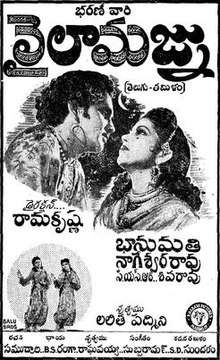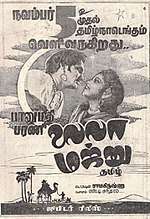Laila Majnu (1949 film)
| Laila Majnu | |
|---|---|
 Theatrical release poster | |
| Directed by | P. S. Ramakrishna Rao |
| Produced by |
P. S. Ramakrishna Rao Bhanumathi Ramakrishna (Presents) |
| Written by |
Samudrala Sr (story / dialogues) |
| Screenplay by | P. S. Ramakrishna Rao |
| Based on | Sufi's Laila-Majnu |
| Starring |
Akkineni Nageswara Rao Bhanumathi Ramakrishna |
| Music by | C. R. Subburaman |
| Cinematography | B. S. Ranga |
| Edited by | P. S. Ramakrishna Rao |
Production company | |
Release date |
|
Running time | 169 mins |
| Country | India |
| Language | Telugu |
Laila Majnu is a 1949 Telugu historical film, based on the Sufi Legend of Laila-Majnu, produced and directed by P. S. Ramakrishna Rao under the Bharani Pictures banner. It stars Akkineni Nageswara Rao and Bhanumathi Ramakrishna in the lead roles, with music composed by C. R. Subburaman. The film was simultaneously released in Tamil with same title.[1] The film was recorded as a Super Hit at the box office.[1] S. D. Sundharam wrote the dialogues and lyrics for the Tamil version.
Plot
Laila (Bhanumathi Ramakrishna) is the daughter of Ameer Sarvaar (Mukkamala) and Khais (Akkineni Nageswara Rao), the son of Ameer Umri (Arani Satyanarayana). Love blossoms between Laila and Khais as they grow up. Ameer Sarvaar, unable to dissuade his daughter from seeing Khais, shifts to Mecca. Khais follows her to Mecca and roams in the streets uttering her name. People take him to be a mad person (Majnu) and throw stones at him. The story takes a lot of twists and turns from here on. The King of Iraq (C.S.R.), who comes on a visit to Mecca, sees Laila and decides to marry her. Meanwhile, Ameer Umri pleads with his erstwhile friend Sarvaar to save his son. Sarvaar agrees to get his daughter married to Khais if it is proved that he is not mad. A test is conducted and Khais emerges successful. Just when the marriage is to be performed, Sarvaar receives a proposal from the King of Iraq that he wishes to marry Laila. Sarvaar changes his mind, and performs his daughter’s marriage with the King. Laila leaves for Iraq and Khais wanders aimlessly in the desert. The King already has a mistress Zareena (Sriranjani Jr.). On coming to know of Laila’s story, she tries to help her. Soon thereafter, the Prince repents, calls Laila his sister and sends her back to Khais. The lovers are about to meet in the desert, but fate wills it otherwise and a heavy sandstorm takes its toll.
Cast
- Akkineni Nageswara Rao as Qais / Majnu
- Bhanumathi Ramakrishna as Laila
- Mukkamala as Ameer Sarvar
- C.S.R. as Rakkin Prabhu
- Sriranjani as Zarina
- Kasturi Siva Rao as Anwar
- Arani Satyanarayana as Ammer Zamri
- Seetharam as Moulvi
- Hemalatha as Begum
- Surabhi Balasaraswathi as Zohrah
- K. V. Subba Rao as Kubla Khan
Crew
- Art: Kotkangar, K. Nageswara Rao
- Choreography: Vedantam Raghavaiah
- Story - Dialogues - Lyrics: Samudrala Sr
- Playback: Ghantasala, Bhanumathi Ramakrishna, R. Balasaraswathi Devi, P. Leela, Jikki, Susarla Dakshinamurthy, Madhavapeddi Satyam, Kasthuri Siva Rao
- Music: C. R. Subburaman
- Cinematography: B. S. Ranga
- Presenter: Bhanumathi Ramakrishna
- Screenplay - Editing - Producer - Direction: P. S. Ramakrishna Rao
- Banner: Bharani Pictures
Soundtrack
| Laila Majnu | |
|---|---|
| Film score by C. R. Subburaman | |
| Released | 1949 |
| Genre | Soundtrack |
| Length | 47:25 |
| Producer | C. R. Subburaman |
Music composed by C. R. Subburaman. Lyrics by Samudrala Sr. The song Preme Neramouna is an evergreen blockbuster. Music released on AVM Audio Company.
| S. No. | Song Title | Singers | length |
|---|---|---|---|
| 1 | "Neevene Naa Chaduvu" | Ghantasala, Bhanumathi Ramakrishna, P. Leela, Jikki | 3:00 |
| 2 | "Aaha Pahliyanchega" | Bhanumathi Ramakrishna | 2:07 |
| 3 | "Viritavula Lona" | Ghantasala, Bhanumathi Ramakrishna | 3:08 |
| 4 | "Cherararo" | Ghantasala, Bhanumathi Ramakrishna | 2:30 |
| 5 | "Raavo Naanu Marachitivo" | Ghantasala, Bhanumathi Ramakrishna | 2:44 |
| 6 | "Ninu Basi Povudana" | Bhanumathi Ramakrishna | 3:10 |
| 7 | "Preme Neramounaa" | Bhanumathi Ramakrishna | 2:57 |
| 8 | "Chelunigani Nijamidani" | Ghantasala, Bhanumathi Ramakrishna | 4:08 |
| 9 | "Payanamye Priyathama" | Ghantasala | 2:55 |
| 10 | "Ela Pagaye" | R. Balasaraswathi Devi | 2:16 |
| 11 | "Ninugani Manasuna" | P. Leela | 2:14 |
| 12 | "Assaalaa Malekkum" | Kasthuri Siva Rao | 2:47 |
| 13 | "Manasu Gadaa Khudaa" | Ghantasala, Susarla Dakshinamurthy, Madhavapeddi Satyam | 4:30 |
| 14 | "Andala Chinnadana" | P. Leela, Jikki | 2:43 |
| 15 | "Eenaati Mapata" | P. Leela, Jikki | 2:21 |
| 16 | "Tanedano" | Bhanumathi Ramakrishna | 0:59 |
| 17 | "Neeve Nenaa Chaduvu" | Ghantasala | 2:56 |
Trivia

Laila Majnu was first made as a silent film in 1922 by J. J. Madan and again in 1927 by Manilal Joshi. Noted filmmaker Kanjibhai Rathod made it in Hindi in 1931 after the films became talkies. J. J. Madan remade it in Hindi in 1931. In 1936, it was produced by East India Pictures in Persian. In 1940, Dharmaveer Singh made the same story in Punjabi, and in 1941, Sarnad Pictures made a version in Pushtu language. In 1945 it was made in Hindi featuring Swaran Lata as Leila and Nazir Ahmed as Majnu. It was a box office hit.
This verson made by Bhanumathi was dubbed into Tamil and released simultaneously with the Telugu version. F. Nagoor made another Laila Majnu in 1950 under the banner Balaji Pictures and shot at Newtone studios with T. R. Mahalingam and M. V. Rajamma in the lead roles. The story was again made in 1953, 1976 (in Hindi and Bengali), and later in 1982.[2]
Production
Laila Majnu, an ancient epic of love, is an integral part of classic Sufi literature. Hashmet Shah has told it, so has Amir Khusro. Nizami Ganjavi’s 12th century version in scintillating verse filled with allegorical flourishes has been translated into numerous languages. Mian Mohammad Bakhsh’s interpretation of the epic is held as an acclaimed treatise in Pakistan till this day. The tragic tale of Majnoon and Laila is said to have its foundations in true events that occurred in the 7th century.
With his first film, Rathnamala, turning a box office hit, studio owner and director Ramakrishna was on the lookout for a suitable subject for Bharani’s next venture. Fascinated by the first Hindi talkie version of Laila Majnu (1945), which he had seen in Bombay, he made the choice. His production chief D. L. Narayana agreed with him. A screening of the Hindi version was arranged for his actress-wife Bhanumathi and Akkineni Nageswara Rao, whom he had thought of for the protagonist’s role. Samudrala Raghavacharya was assigned the job of writing the script and the dialogue.
The sandstorm scene especially is worth mentioning. Instead of veteran cameraman Jiten Banerjee, who cranked for Rathnamala, Ramakrishna took B. S. Ranga as the cameraman without even knowing how efficient his work was. Ranga who bagged this assignment thanks to his brother Garudachari, a close friend of Ramakrishna, proved his worth and it was the turning point in his future life and career. Besides excellent photography, sound designing (by V. Srinivasa Raghavan under whom later day’s popular director K. Viswanath worked as an assistant), the period sets created by art directors Goadgoankar and K. Nageswara Rao.
Critical reception
An article published in THE HINDU wrote about this movie "While the opulent palace, garden and other sets were put up in the floor, the desert set with a pond, palm trees (to resemble date trees found in deserts) and sand dunes were created in the open space between the studio and the recording theatre and the scenes were shot there during the nights for the right effect. The result of this entire effort was reflected in audience’s appreciation of the movie."
Notes
- 1 2 M. L. Narasimhan (1 September 2012). "Laila majnu (1949)". The Hindu. Archived from the original on 24 May 2017. Retrieved 31 January 2017.
- ↑ Guy, Randor (19 February 2012). "Leila Majnu 1950". The Hindu. Archived from the original on 14 August 2014. Retrieved 24 May 2017.
References
- Randor Guy (2 January 2006). "Tribute To A Legend". The Hindu. Retrieved 24 May 2017.
External links
- Laila Majnu on IMDb
- Full Feature Film on YouTube (Tamil)